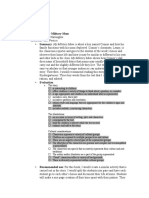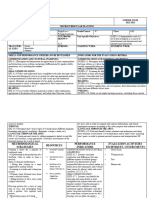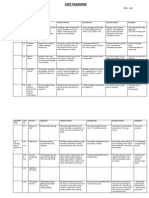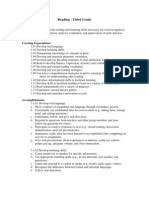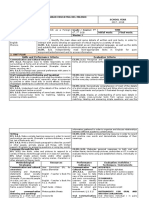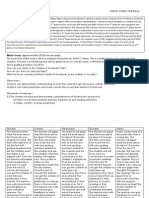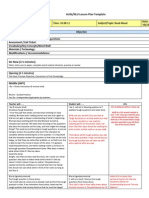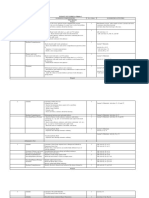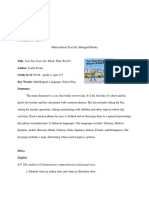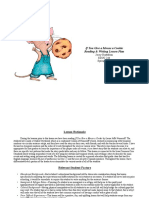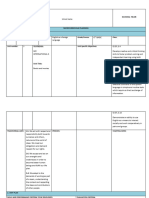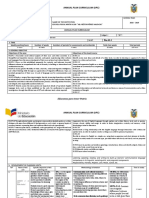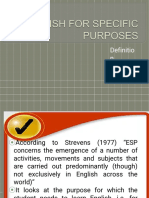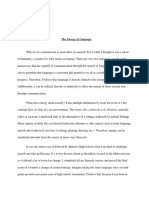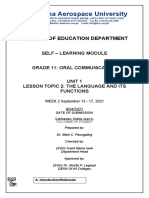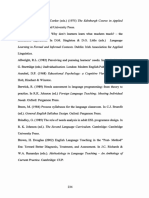Multicultural
Text Set
Nicole Frum
�Yoko’s Paper Cranes
by Rosemary Wells
Summary:
While living in Japan, Yoko feeds the cranes in the garden with her
grandmother, Obaasan, and learn that the cranes only stay for a few months a
year. Yoko’s Grandfather, Ojiisan, teaches her to fold paper cranes and other
origami animals. Yoko and her parents leave Japan to live in California and she
sends letters to her Grandparents every week and for Obaasan’s birthday Yoko
sends her Origami cranes that she made because it is Winter and Obaasan must
be missing the cranes. She also includes a birthday note written in Japanese
saying that she will soon come back to Japan just like the cranes.
Appropriate Age/ Grade: Pre-K to Kindergarten
Key words: Japanese culture including kimonos, origami, and tategaki writing.
� Evaluation and Recommended
use: Yoko’s Paper Cranes
This book would be used as an
introduction to a cultural study of Japan
for Pre-K or Kindergarteners as it
introduces some traditional Japanese
cultural ideas like traditional dress,
origami, and has a traditional Japanese
art style throughout the book. It also
includes a small piece of Japanese
writing which is a character based
writing system.
– After reading this book I think that you could have someone knowledgeable from the community come and talk to the
class and answer questions, allow the students to try and paint a Japanese character, and let them attempt to fold an
origami animal. This book also allows discussion with the class about how some people are not originally from America
and allow the class to connect their own ideas and experiences whether it be missing a grandparent or being an
immigrant.
� SOL’s: Yoko’s Paper Cranes
K.1 The student will demonstrate growth in the use of oral language. K.5 The student will understand how print is organized and read.
a) Listen to a variety of literary forms, including stories and poems. b) Identify front cover, back cover, and title page of a book.
e) Use complete sentences that include subject, verb, and object. c) Distinguish between print and pictures.
K.2 The student will expand understanding and use of word meanings. d) Follow words form left to right and from top to bottom on a printed page.
a) Increase listening and speaking vocabularies. K.8 The student will expand vocabulary.
c) Use words to describe/name people, places, or things. a) Discuss meanings of words.
d) Use words to describe/name location, size, color, or shape. b) Develop vocabulary by listening to a variety texts read alouds.
e) Use words to describe/name actions. K.9 The student will demonstrate comprehension of fictional texts.
f) Ask about words not understood. b) Relate previous experiences to what is read.
g) Use vocabulary from other content areas. d) Begin to ask and answer questions about what is read.
K. 3 The student will build oral communication skills. g) Discuss characters, setting, and events.
a) Express ideas in complete sentences and express needs through direct
requests.
c) Begin to follow implicit rules for conversation, including taking turns and
staying on topic.
d) Listen and speak in informal conversations with peers and adults.
e) Participate in group and partner discussions about various texts and topics.
g) Follow one- and two-step directions.
h) Ask how and why questions.
�A Boy and a Jaguar
By Alan Rabinowitz
Summary:
Alan is a boy who stutters but can speak fluently when talking
with his variety of pets. He knows what it is like to feel like you don’t
have a voice and promises to be the voice for animals. When Alan gets
older he takes special classes for his stutter and becomes a wildlife
conservationist and ends up getting a jaguar preserve in Belize.
Age Appropriate: K-3rd
Key words: Stutter, Jaguars, Conservation
� Evaluation and Recommended
Use: A Boy and a Jaguar
I think this book meets the ‘standards of
success’ because it is about a boy who
grows up to accomplish something he is I think that this book would be a
passionate about despite his good read aloud to a whole class
exceptionality. Also the author of the when discussing ability,
book is the main character and so the stereotyping, or acceptance of
book accurately portrays his point of people unlike you. I think that I
would do this book with a
view. The book also shows a positive
collection of other books about
relationship between characters of
people with exceptionalities and
different cultures when the main
have it accompany class
character who is Caucasian has to go
discussions.
before a council in Belize and it is their
ruling that decides the outcome.
� SOL’s: A Boy and a Jaguar
1.10 The student will read and demonstrate comprehension of
1.1 The student will continue to demonstrate growth in a variety of nonfiction texts.
the use of oral language. a)Preview the selection
e)Express ideas orally in complete sentences. b) Use prior and background knowledge as context for new
1.3 The student will change or adapt oral language to fit learning.
the situation. c) Set a purpose for reading.
a)Initiate conversation with peers or adults. d) Identify text features such as pictures, headings, charts, and
captions.
b)Follow rules for conversation using appropriate voice
e) Make and confirm predictions.
level in small-group setting. f) Ask and answer who, what, where, when, why, and how
c)Ask and respond to questions. questions about what is read.
1.8 The student will expand vocabulary. g) Identify the main idea.
a)Discuss meanings of words in context. h) Read and reread familiar passages with fluency, accuracy, and
b)Develop vocabulary by listening to and reading a meaningful expression
variety of texts.
c)Ask for the meaning of unknown words and make
connections to familiar words.
d)Use text clues such as words or pictures to discern
meanings of unknown words.
e)Use vocabulary from other content areas.
�Yo Soy Muslim
By Mark Gonzales
Summary:
This book is a letter from a father to his daughter who is Latina
and Arabic as well as Muslim. He talks about the questions she might
face about herself from others and tries to instill a sense of pride and
magic in her identity.
Age appropriate: 1st-4th grade
Key Words: Multi-Cultural, Religion, Persecution, Pride
�Evaluation and Recommended
Use: Yo Soy Muslim
This story is one about a girl who has a combination of multiple
cultures. So while she is a part of each of them she does not fully fit
into any of them. I think that this would be a great book for discussing
what makes a person who they are and what the benefits as well as
the hardships that come along with being multi-cultural. This book is
a great example of finding pride and in this book almost a sense of
magic in your cultural identity and celebrating what makes someone
unique.
I think that this book would be a great book to spur discussion with students
about what cultural identity is and how our culture, religion, etc. makes up
who we are as a person. I would want the students to talk about how they
identify themselves and if they aren’t sure to go home and talk to their
parents and family. I think that this could start a project of each student
presenting about their individual cultures and maybe having family member
to come and talk to the class about their cultures.
�SOL’s: Yo Soy Muslim
3.5 The student will read and demonstrate comprehension of fictional text
and poetry.
a)Set a purpose for reading.
3.1 The student will use effective communication skills in group b) Make connections between previous experiences and reading
activities. selections.
a)Listen attentively by making eye contact, facing the speaker, c) Make, confirm, or revise predictions.
asking questions, and summarizing what is said. d) Compare and contrast settings, characters, and events.
b) Ask and respond to questions from teachers and other group e) Identify the author’s purpose.
members. f) Ask and answer questions about what is read.
c) Explain what has been learned. g) Draw conclusions about text.
d) Use language appropriate for context. h) Identify the problem and solution.
e) Increase listening and speaking vocabularies. i)Identify the main idea.
3.2 The student will present brief oral reports using visual media. j) Identify supporting details.
a)Speak clearly. k) Use reading strategies to monitor comprehension throughout the
b) Use appropriate volume and pitch. reading process.
c) Speak at an understandable rate. l)Differentiate between fiction and nonfiction.
d) Organize ideas sequentially or around major points of m) Read with fluency and accuracy.
information. 3.9 The student will write for a variety of purposes.
e) Use contextually appropriate language and specific vocabulary a) Identify the intended audience.
to communicate ideas. b) Use a variety of prewriting strategies.
3.4 The student will expand vocabulary when reading c) Write a clear topic sentence focusing on the main idea.
c) Apply meaning clues, language structure, and phonetic d) Write a paragraph on the same topic.
strategies. e) Use strategies for organization of information and elaboration according
d) Use context to clarify meaning of unfamiliar words. to the type of writing.
e) Discuss meanings of words and develop vocabulary by f) Include details that elaborate the main idea.
listening and reading a variety of texts. g) Revise writing for clarity of content using specific vocabulary and
f) Use vocabulary from other content areas. information.
�Growing up Pedro
By Matt Tavares
Summary:
“Before Pedro Martinez pitched the Red Sox to the World Series
championship, before he was named to the All-Star team eight times,
before he won the Cy Young Award three times, he was a kid from a
place called Manoguayabo in the Dominican Republic. Pedro loved
baseball more than anything, and his older brother Ramon was the best
pitcher he’d ever seen. He dreamed of the day he and his brother could
play together in the major leagues.”
Age Appropriate: 2nd-5th Grade
Key words: Baseball, Immigration, Hard work, dream, Brother
� Evaluation and Recommended Use:
Growing Up Pedro
This story about the Martinez brothers is
not only one about working hard to
achieve you dreams but it also talks
about the hardships of being an
immigrant in a country where the
language is different than your own. This
story is also about how even though the
brothers moved to America and Canada
for their baseball careers they never lost
touch with their home and culture.
I think that this book would be a great read aloud for a baseball theme or a discussion about immigrating to
other countries and even different family structures in different cultures when paired with other books
showing diverse family structure.
� SOL’s: Growing Up Pedro
4.1 The student will use effective oral communication skills 4.5 The student will read and demonstrate comprehension of
in a variety of settings. fictional texts, narrative nonfiction texts, and poetry.
a)Present accurate directions to individuals and small a)Explain the author’s purpose.
groups. b) Describe how the choice of language, setting, characters,
b) Contribute to group discussions across content areas. and information contributes to the author’s purpose.
c) Seek ideas and opinions of others. c) Identify the main idea.
d) Use evidence to support opinions. d) Summarize supporting details.
e) Use grammatically correct language and specific e) Identify the problem and solution.
vocabulary to communicate ideas. f) Describe the relationship between text and previously read
f) Communicate new ideas to others. materials.
g) Demonstrate the ability to collaborate with diverse g) Identify sensory words.
teams. h) Draw conclusions/make inferences about text.
h) Demonstrate the ability to work independently. i)Make, confirm, or revise predictions.
j) Identify cause and effect relationships.
k) Use reading strategies throughout the reading process to
monitor comprehension.
l) Read with fluency and accuracy.
�My Rows and Piles of Coins
By Tololwa M. Mollel
Summary:
“The market is full of wonderful things—roasted peanuts, rice
cakes, toy trucks, kites—but Saruni doesn’t but any of them.
He is saving for something special. How happy and proud he
will be when he can help his mother carry heavy goods to
market on his very own bicycle!”
Age Appropriate: 1st- 4rd Grade
Key words: Family, Market, Tanzania, Delayed Gratification,
� Evaluation and Recommended Use:
My Rows and Piles of Coins
This book is a good example of different culture. By
looking at what he calls his parents, his chores, and
their market, students can find differences from their
own culture while still relating to wanting to save
money earned for something big like a bicycle. The
author based this story on her own experience
growing up in Tanzania.
I think this would be a good book to do a compare and contrast of culture with a venn diagram with students.
You could compare the names for family members, chores, school, seasons, currency, dress, transportation,
lighting, and food sources.
� SOL’s: My Rows and Piles of Coins
4.1 The student will use effective oral communication skills 4.5 The student will read and demonstrate comprehension of
in a variety of settings. fictional texts, narrative nonfiction texts, and poetry.
a)Present accurate directions to individuals and small a)Explain the author’s purpose.
groups. b) Describe how the choice of language, setting, characters,
b) Contribute to group discussions across content areas. and information contributes to the author’s purpose.
c) Seek ideas and opinions of others. c) Identify the main idea.
d) Use evidence to support opinions. d) Summarize supporting details.
e) Use grammatically correct language and specific e) Identify the problem and solution.
vocabulary to communicate ideas. f) Describe the relationship between text and previously read
f) Communicate new ideas to others. materials.
g) Demonstrate the ability to collaborate with diverse g) Identify sensory words.
teams. h) Draw conclusions/make inferences about text.
h) Demonstrate the ability to work independently. i)Make, confirm, or revise predictions.
j) Identify cause and effect relationships.
k) Use reading strategies throughout the reading process to
monitor comprehension.
l) Read with fluency and accuracy.
